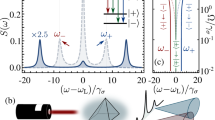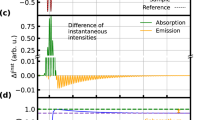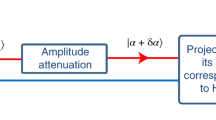Abstract
The coherent interaction between a two-level system and electromagnetic fields serves as a foundation for fundamental quantum physics and modern photonic quantum technology. A profound example is resonance fluorescence, where the non-classical photon emission appears in the form of a Mollow-triplet when a two-level system is continuously driven by a resonant laser. Pushing resonance fluorescence from a static to dynamic regime by using short optical pulses generates on-demand emissions of highly coherent single photons. Further increasing the driving strength in the dynamical regime enables the pursuit of exotic non-classical light emission in photon number superposition, photon number entanglement and photon bundle states. However, the long-sought-after spectrum beyond the Mollow-triplet, a characteristic of dynamic resonance fluorescence under strong driving strength, has not yet been observed. Here we report the direct observation and systematic investigations of dynamic resonance fluorescence spectra beyond the Mollow-triplet in a solid-state cavity quantum electrodynamic system. The dynamic resonance fluorescence spectra—with up to five pairs of side peaks, excitation detuning-induced spectral asymmetry, and cavity filtering effects—are observed and quantitatively modelled by a full-quantum model with phonon scattering included. Time-resolved measurements further reveal that the multiple side peaks originate from interference of the emission associated with different temporal positions of the excitation pulses. Our work facilitates the generation of a variety of exotic quantum states of light with dynamic driving of two-level systems.
This is a preview of subscription content, access via your institution
Access options
Access Nature and 54 other Nature Portfolio journals
Get Nature+, our best-value online-access subscription
$29.99 / 30 days
cancel any time
Subscribe to this journal
Receive 12 print issues and online access
$209.00 per year
only $17.42 per issue
Buy this article
- Purchase on Springer Link
- Instant access to full article PDF
Prices may be subject to local taxes which are calculated during checkout





Similar content being viewed by others
Data availability
The data that support the plots within this paper and other findings of this study are available on figshare (https://doi.org/10.6084/m9.figshare.24501241). All other data used in this study are available from the corresponding author on reasonable request.
References
Kimble, H. & Mandel, L. Theory of resonance fluorescence. Phys. Rev. A 13, 2123 (1976).
Loudon, R. The Quantum Theory of Light (Oxford Univ. Press, 2000).
Fox, M. Quantum Optics: An Introduction Vol. 15 (Oxford Univ. Press, 2006).
Kimble, H. J., Dagenais, M. & Mandel, L. Photon antibunching in resonance fluorescence. Phys. Rev. Lett. 39, 691 (1977).
Kim, J., Benson, O., Kan, H. & Yamamoto, Y. A single-photon turnstile device. Nature 397, 500–503 (1999).
Xu, X. et al. Coherent optical spectroscopy of a strongly driven quantum dot. Science 317, 929–932 (2007).
Nick Vamivakas, A., Zhao, Y., Lu, C.-Y. & Atatüre, M. Spin-resolved quantum-dot resonance fluorescence. Nat. Phys. 5, 198–202 (2009).
Flagg, E. B. et al. Resonantly driven coherent oscillations in a solid-state quantum emitter. Nat. Phys. 5, 203–207 (2009).
He, Y. et al. Dynamically controlled resonance fluorescence spectra from a doubly dressed single InGaAs quantum dot. Phys. Rev. Lett. 114, 097402 (2015).
Schulte, C. H. et al. Quadrature squeezed photons from a two-level system. Nature 525, 222–225 (2015).
Astafiev, O. et al. Resonance fluorescence of a single artificial atom. Science 327, 840–843 (2010).
Ng, B. L., Chow, C. H. & Kurtsiefer, C. Observation of the Mollow triplet from an optically confined single atom. Phys. Rev. A 106, 063719 (2022).
Aspect, A., Roger, G., Reynaud, S., Dalibard, J. & Cohen-Tannoudji, C. Time correlations between the two sidebands of the resonance fluorescence triplet. Phys. Rev. Lett. 45, 617 (1980).
Ulhaq, A. et al. Cascaded single-photon emission from the Mollow triplet sidebands of a quantum dot. Nat. Photon. 6, 238–242 (2012).
Somaschi, N. et al. Near-optimal single-photon sources in the solid state. Nat. Photon. 10, 340–345 (2016).
Unsleber, S. et al. Highly indistinguishable on-demand resonance fluorescence photons from a deterministic quantum dot micropillar device with 74% extraction efficiency. Opt. Express 24, 8539–8546 (2016).
He, Y.-M. et al. Deterministic implementation of a bright, on-demand single-photon source with near-unity indistinguishability via quantum dot imaging. Optica 4, 802–808 (2017).
Wang, H. et al. Towards optimal single-photon sources from polarized microcavities. Nat. Photon. 13, 770–775 (2019).
Uppu, R. et al. Scalable integrated single-photon source. Sci. Adv. 6, eabc8268 (2020).
Tomm, N. et al. A bright and fast source of coherent single photons. Nat. Nanotechnol. 16, 399–403 (2021).
Zhou, X., Zhai, L. & Liu, J. Epitaxial quantum dots: a semiconductor launchpad for photonic quantum technologies. Photon. Insights 1, R07 (2023).
Fischer, K. A. et al. Signatures of two-photon pulses from a quantum two-level system. Nat. Phys. 13, 649–654 (2017).
Loredo, J. et al. Generation of non-classical light in a photon-number superposition. Nat. Photon. 13, 803–808 (2019).
Wein, S. C. et al. Photon-number entanglement generated by sequential excitation of a two-level atom. Nat. Photon. 16, 374–379 (2022).
Moelbjerg, A., Kaer, P., Lorke, M. & Mørk, J. Resonance fluorescence from semiconductor quantum dots: beyond the Mollow triplet. Phys. Rev. Lett. 108, 017401 (2012).
Gustin, C., Manson, R. & Hughes, S. Spectral asymmetries in the resonance fluorescence of two-level systems under pulsed excitation. Opt. Lett. 43, 779–782 (2018).
Liu, F. et al. High Purcell factor generation of indistinguishable on-chip single photons. Nat. Nanotechnol. 13, 835–840 (2018).
Schöll, E. et al. Crux of using the cascaded emission of a three-level quantum ladder system to generate indistinguishable photons. Phys. Rev. Lett. 125, 233605 (2020).
Zhai, L. et al. Quantum interference of identical photons from remote gaas quantum dots. Nat. Nanotechnol. 17, 829–833 (2022).
Fischer, K. A. et al. Self-homodyne measurement of a dynamic Mollow triplet in the solid state. Nat. Photon. 10, 163–166 (2016).
Rzazewski, K. & Florjanczyk, M. The resonance fluorescence of a two-level system driven by a smooth pulse. J. Phys. B 17, L509 (1984).
He, Y.-M. et al. On-demand semiconductor single-photon source with near-unity indistinguishability. Nat. Nanotechnol. 8, 213–217 (2013).
Gustin, C. & Hughes, S. Pulsed excitation dynamics in quantum-dot–cavity systems: limits to optimizing the fidelity of on-demand single-photon sources. Phys. Rev. B 98, 045309 (2018).
Nazir, A. & McCutcheon, D. P. S. Modelling exciton–phonon interactions in optically driven quantum dots. J. Phys. 28, 103002 (2016).
Eberly, J. H., Kunasz, C. V. & Wodkiewicz, K. Time-dependent spectrum of resonance fluorescence. J. Phys. B 13, 217 (1980).
Su, R. et al. Bright and pure single-photons from quantum dots in micropillar cavities under up-converted excitation. Sci. Bull. 63, 739–742 (2018).
Liu, S. et al. Dual-resonance enhanced quantum light–matter interactions in deterministically coupled quantum-dot-micropillars. Light Sci. Appl. 10, 158 (2021).
Wei, Y. et al. Tailoring solid-state single-photon sources with stimulated emissions. Nat. Nanotechnol. 17, 470–476 (2022).
Chen, Y. et al. Fiber coupled high count-rate single-photon generated from InAs quantum dots. J. Semicond. 42, 072901 (2021).
Vagov, A., Croitoru, M. D., Axt, V. M., Kuhn, T. & Peeters, F. Nonmonotonic field dependence of damping and reappearance of Rabi oscillations in quantum dots. Phys. Rev. Lett. 98, 227403 (2007).
Lei, M. et al. Many-body cavity quantum electrodynamics with driven inhomogeneous emitters. Nature 617, 271–276 (2023).
Savage, C. M. Resonance fluorescence spectrum of an atom strongly coupled to a cavity. Phys. Rev. Lett. 63, 1376 (1989).
Hopfmann, C. et al. Transition from Jaynes–Cummings to Autler–Townes ladder in a quantum dot–microcavity system. Phys. Rev. B 95, 035302 (2017).
Tomm, N. et al. Photon bound state dynamics from a single artificial atom. Nat. Phys. 19, 857–862 (2023).
Cogan, D., Su, Z.-E., Kenneth, O. & Gershoni, D. Deterministic generation of indistinguishable photons in a cluster state. Nat. Photon. 17, 324–329 (2023).
Coste, N. et al. High-rate entanglement between a semiconductor spin and indistinguishable photons. Nat. Photon. 17, 582–587 (2023).
Boots, K. et al. Signature of dynamically dressed states. Preprint at arXiv https://doi.org/10.48550/arXiv.2305.15827 (2023).
Acknowledgements
This research was supported by the National Key Research and Development Program of China (2021YFA1400800, 2018YFA0306101); the National Natural Science Foundation of China (62035017, 12304409); the Guangdong Special Support Program (2019JC05X397); the National Super-Computer Center in Guangzhou; and the Natural Sciences and Engineering Research Council of Canada (NSERC).
Author information
Authors and Affiliations
Contributions
J.L. and X.H.W. conceived the project; S.F.L., J.L. and H.Q.L. designed the epitaxial structure and the devices; H.Q.L., Y.Y. and H.Q.N. grew the quantum dot wafers; S.F.L. and X.S.L. fabricated the devices; S.F.L. built the set-up and performed the optical measurements; C.G. performed all the theoretical modelling with input from S.H., and wrote the main theory parts of the paper and the Supplementary Information; S.F.L., J.L. and C.G. analysed the data; J.L. and S.F.L. prepared the main manuscript with inputs from all authors; J.L., S.H., Z.C.N. and X.H.W. supervised the project.
Corresponding authors
Ethics declarations
Competing interests
The authors declare no competing interesta.
Peer review
Peer review information
Nature Photonics thanks the anonymous reviewers for their contribution to the peer review of this work.
Additional information
Publisher’s note Springer Nature remains neutral with regard to jurisdictional claims in published maps and institutional affiliations.
Extended data
Extended Data Fig. 1 Schematic of the setup for optical characterizations.
The setup consists of 6 functional sections including a cryogenic resonant excitation system, a pulse shaper, a power controller, a spectrometer, an etalon filter, and a lifetime measurement section. The measurements start from shaping the femtosecond (fs) pulses to a picosecond (ps) pulse with tunable wavelength and controllable pulse width between 10 ps and 55 ps by a homemade 4f system and gratings. The power of the shaped ps pulse is then controlled by rotating a polarizer between two fixed polarizers with the same polarization axis and monitored by a power meter. The resonant excitation of the QD is based on a cross-polarization scheme, pairs of the polarizer and half-wave plate are inserted into the excitation and collection optical path for polarization control. RF from QD is coupled to an optical fibre, guided to a spectrometer for spectrum analysis, or used for time-resolved measurement after filtering with an etalon. BS: beam splitter, HWP: half-wave plate, LP filter, PC: polarization controller.
Extended Data Fig. 2 Experimental parameters of the investigated devices.
(a) Cavity spectrum of device 1 under high-power above-band excitation. A Q-factor of 10584 is acquired by fitting the data with a Lorentz function. Inset: scanning electron microscope (SEM) image of device 1 with a diameter of 2.5 μm. (b) π-pulse RF spectra of the QD in device 1 when QD is on/off-resonance with the cavity mode. (c) Corresponding on/off-resonance lifetimes of the QD at π pulse. (d) Rabi oscillation of device 1 extracted from Fig. 2(b),(e) Parameters of the devices investigated in the main text. The Purcell factors are calculated by using \({{{{\rm{F}}}}}_{{{{\rm{p}}}}}=\frac{{\tau }_{{{{\rm{off}}}}}}{{\tau }_{{{{\rm{on}}}}}}-1\), where τon and τoff are the lifetimes of the QD under resonant and off-resonant conditions, respectively. The extraction efficiencies are calculated with \(\eta =\frac{{{{{\rm{F}}}}}_{{{{\rm{p}}}}}}{{{{{\rm{F}}}}}_{{{{\rm{p}}}}}+1}\times \frac{Q}{{Q}_{0}}\) in which Q is the quality factor of the micropillar and Q0 is the quality factor of the unetched planar cavity.
Extended Data Fig. 3 Laser detuning dependent RF spectra.
(a) Measured laser detuning dependent dynamic RF spectra of device 1 at 4π pulse area. (b) Calculated dynamic RF at 4π pulse area with varied Δx. (c) Measured laser detuning dependent dynamic RF of device 1 at 6π pulse area. (d) Calculated dynamic RF at 6π pulse area with varied Δx. The pulse width is kept for 46 ps for this experiment.
Extended Data Fig. 4 Dynamic RF with varied pulse width τfw (FWHM of the laser pulse) under the condition of Δc = 0 for device 1 at 14 K.
(a) Excitation condition: Δx = 0, τfw = 13 ps. (b) Contour plots of the measured RF spectra [under the condition in (a)] as a function of driving pulse amplitude. The side peaks are labelled with s1 to s2. (c) Log-scale RF spectra [under the condition in (a)] at 4π pulse areas. The position of side peak 1 is pointed out with the dashed line in red. (d) Excitation condition: Δx = 0, τfw = 24 ps. (e) Contour plots of the measured RF spectra [under the condition in (d)] as a function of driving pulse amplitude. (f) Log-scale RF spectra [under a condition in (d)] at 4π pulse areas. (g) Excitation condition: Δx = 0, τfw = 54 ps. (h) Contour plots of the measured RF spectra [under the condition in (g)] as a function of driving pulse amplitude. (i) Log-scale RF spectra [under the condition in (g)] at 4π pulse areas. The side peaks get close to each other and move toward the central peak as the pulse width increases.
Extended Data Fig. 5 Dynamic RF with varied pulse width τfw under the condition of Δc/(2π)= −26 GHz for device 1 at 4 K.
(a) Excitation condition: Δx = 0, τfw = 14 ps. (b) Contour plots of the measured RF spectra [under the condition in (a)] as a function of driving pulse amplitude. The side peaks are labelled with s1 to s3. (c) RF spectra [under the condition in (a)] at 4π and 6π pulse areas. (d) Excitation condition: Δx = 0, τfw = 25 ps. (e) Contour plots of the measured RF spectra [under the condition in (d)] as a function of driving pulse amplitude. (f) RF spectra [under a condition in (d)] at 4π and 6π pulse areas. (g) Excitation condition: Δx = 0, τfw = 54 ps. (h) Contour plots of the measured RF spectra [under the condition in (g)] as a function of driving pulse amplitude. (i) RF spectra [under a condition in (g)] at 4π and 6π pulse areas. Because of the enhancement of the cavity mode, the intensity of the peaks on the left side is comparable with that of the central peak. The side peaks are clearly observable even in the linear scale.
Extended Data Fig. 6 Comparison of different models for reproducing the experimental result in Fig. 3(c).
(a) The TLS is driven directly by the laser with \({H}_{{{{\rm{drive}}}}}(t)=\frac{\Omega (t)}{2}({\sigma }^{+}+{\sigma }^{-})\), we use a naive bad-cavity model to eliminate the cavity mode, and phonons are not considered. (b) A full quantum model with a quantized cavity mode is adopted, with \({H}_{{{{\rm{drive}}}}}(t)=\frac{\Omega (t)}{2}(a+{a}^{{\dagger} })\), and phonons are not considered. The intensity asymmetry of the side peaks due to cavity filtering is reproduced, which agrees well with the experiment. (c) The cavity is driven with \({H}_{{{{\rm{drive}}}}}(t)=\frac{\Omega (t)}{2}(a+{a}^{{\dagger} })\), and phonons are included. This full model gives rise to additional phonon-induced features, also visible in the experiment, as highlighted by the white dotted line. (d) Contour plots of the measured RF spectra as a function of drive pulse amplitude with a pulse width of 54 ps under the condition of Δx = 0 and Δc/(2π)= −26 GHz at 4 K.
Extended Data Fig. 7 Influence of phonons on dynamic RF spectra.
Two additional devices (A and B) at the same sample with Q factors of ~ 7000, Purcell factors of ~ 7, and lifetimes of ~ 80 ps. For device A, QD is in resonance with cavity mode at the temperature of 4 K, and for device B, QD is in resonance with cavity mode at the temperature of 30K. (a) Contour plot of the measured RF spectra as a function of driving pulse amplitude for device A. (b) Rabi oscillation of the main peak in (a). (c) Contours plot of the measured RF spectra as a function of driving pulse amplitude for device B. (d) Rabi oscillation of the main peak in (c).
Supplementary information
Supplementary Information
Supplementary Figs. 1–3 and Discussion.
Rights and permissions
Springer Nature or its licensor (e.g. a society or other partner) holds exclusive rights to this article under a publishing agreement with the author(s) or other rightsholder(s); author self-archiving of the accepted manuscript version of this article is solely governed by the terms of such publishing agreement and applicable law.
About this article
Cite this article
Liu, S., Gustin, C., Liu, H. et al. Dynamic resonance fluorescence in solid-state cavity quantum electrodynamics. Nat. Photon. 18, 318–324 (2024). https://doi.org/10.1038/s41566-023-01359-x
Received:
Accepted:
Published:
Issue Date:
DOI: https://doi.org/10.1038/s41566-023-01359-x



